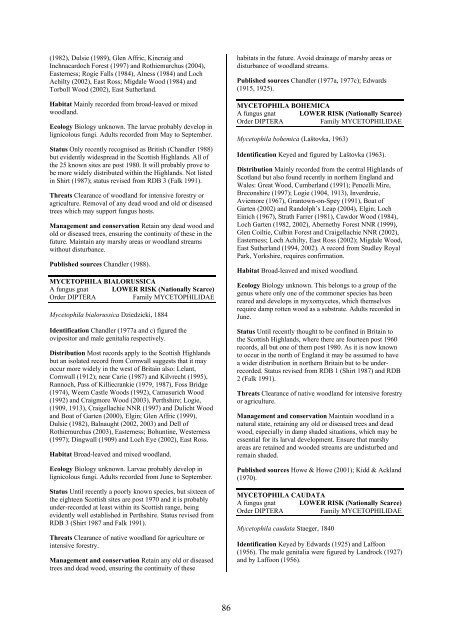Part 2: Nematocera and Aschiza not dealt with by Falk (1991) - JNCC
Part 2: Nematocera and Aschiza not dealt with by Falk (1991) - JNCC
Part 2: Nematocera and Aschiza not dealt with by Falk (1991) - JNCC
Create successful ePaper yourself
Turn your PDF publications into a flip-book with our unique Google optimized e-Paper software.
(1982), Dulsie (1989), Glen Affric, Kincraig <strong>and</strong><br />
Inchnacardoch Forest (1997) <strong>and</strong> Rothiemurchus (2004),<br />
Easterness; Rogie Falls (1984), Alness (1984) <strong>and</strong> Loch<br />
Achilty (2002), East Ross; Migdale Wood (1984) <strong>and</strong><br />
Torboll Wood (2002), East Sutherl<strong>and</strong>.<br />
Habitat Mainly recorded from broad-leaved or mixed<br />
woodl<strong>and</strong>.<br />
Ecology Biology unknown. The larvae probably develop in<br />
lignicolous fungi. Adults recorded from May to September.<br />
Status Only recently recognised as British (Ch<strong>and</strong>ler 1988)<br />
but evidently widespread in the Scottish Highl<strong>and</strong>s. All of<br />
the 25 known sites are post 1980. It will probably prove to<br />
be more widely distributed <strong>with</strong>in the Highl<strong>and</strong>s. Not listed<br />
in Shirt (1987); status revised from RDB 3 (<strong>Falk</strong> <strong>1991</strong>).<br />
Threats Clearance of woodl<strong>and</strong> for intensive forestry or<br />
agriculture. Removal of any dead wood <strong>and</strong> old or diseased<br />
trees which may support fungus hosts.<br />
Management <strong>and</strong> conservation Retain any dead wood <strong>and</strong><br />
old or diseased trees, ensuring the continuity of these in the<br />
future. Maintain any marshy areas or woodl<strong>and</strong> streams<br />
<strong>with</strong>out disturbance.<br />
Published sources Ch<strong>and</strong>ler (1988).<br />
MYCETOPHILA BIALORUSSICA<br />
A fungus gnat LOWER RISK (Nationally Scarce)<br />
Order DIPTERA<br />
Family MYCETOPHILIDAE<br />
Mycetophila bialorussica Dziedzicki, 1884<br />
Identification Ch<strong>and</strong>ler (1977a <strong>and</strong> c) figured the<br />
ovipositor <strong>and</strong> male genitalia respectively.<br />
Distribution Most records apply to the Scottish Highl<strong>and</strong>s<br />
but an isolated record from Cornwall suggests that it may<br />
occur more widely in the west of Britain also: Lelant,<br />
Cornwall (1912); near Carie (1987) <strong>and</strong> Kilvrecht (1995),<br />
Rannoch, Pass of Killiecrankie (1979, 1987), Foss Bridge<br />
(1974), Weem Castle Woods (1992), Camusurich Wood<br />
(1992) <strong>and</strong> Craigmore Wood (2003), Perthshire; Logie,<br />
(1909, 1913), Craigellachie NNR (1997) <strong>and</strong> Dulicht Wood<br />
<strong>and</strong> Boat of Garten (2000), Elgin; Glen Affric (1999),<br />
Dulsie (1982), Balnaught (2002, 2003) <strong>and</strong> Dell of<br />
Rothiemurchus (2003), Easterness; Bohuntine, Westerness<br />
(1997); Dingwall (1909) <strong>and</strong> Loch Eye (2002), East Ross.<br />
Habitat Broad-leaved <strong>and</strong> mixed woodl<strong>and</strong>.<br />
Ecology Biology unknown. Larvae probably develop in<br />
lignicolous fungi. Adults recorded from June to September.<br />
Status Until recently a poorly known species, but sixteen of<br />
the eighteen Scottish sites are post 1970 <strong>and</strong> it is probably<br />
under-recorded at least <strong>with</strong>in its Scottish range, being<br />
evidently well established in Perthshire. Status revised from<br />
RDB 3 (Shirt 1987 <strong>and</strong> <strong>Falk</strong> <strong>1991</strong>).<br />
Threats Clearance of native woodl<strong>and</strong> for agriculture or<br />
intensive forestry.<br />
Management <strong>and</strong> conservation Retain any old or diseased<br />
trees <strong>and</strong> dead wood, ensuring the continuity of these<br />
habitats in the future. Avoid drainage of marshy areas or<br />
disturbance of woodl<strong>and</strong> streams.<br />
Published sources Ch<strong>and</strong>ler (1977a, 1977c); Edwards<br />
(1915, 1925).<br />
MYCETOPHILA BOHEMICA<br />
A fungus gnat LOWER RISK (Nationally Scarce)<br />
Order DIPTERA<br />
Family MYCETOPHILIDAE<br />
Mycetophila bohemica (Laštovka, 1963)<br />
Identification Keyed <strong>and</strong> figured <strong>by</strong> Laštovka (1963).<br />
Distribution Mainly recorded from the central Highl<strong>and</strong>s of<br />
Scotl<strong>and</strong> but also found recently in northern Engl<strong>and</strong> <strong>and</strong><br />
Wales: Great Wood, Cumberl<strong>and</strong> (<strong>1991</strong>); Pencelli Mire,<br />
Breconshire (1997); Logie (1904, 1913), Inverdruie,<br />
Aviemore (1967), Grantown-on-Spey (<strong>1991</strong>), Boat of<br />
Garten (2002) <strong>and</strong> R<strong>and</strong>olph’s Leap (2004), Elgin; Loch<br />
Einich (1967), Strath Farrer (1981), Cawdor Wood (1984),<br />
Loch Garten (1982, 2002), Abernethy Forest NNR (1999),<br />
Glen Coiltie, Culbin Forest <strong>and</strong> Craigellachie NNR (2002),<br />
Easterness; Loch Achilty, East Ross (2002); Migdale Wood,<br />
East Sutherl<strong>and</strong> (1994, 2002). A record from Studley Royal<br />
Park, Yorkshire, requires confirmation.<br />
Habitat Broad-leaved <strong>and</strong> mixed woodl<strong>and</strong>.<br />
Ecology Biology unknown. This belongs to a group of the<br />
genus where only one of the commoner species has been<br />
reared <strong>and</strong> develops in myxomycetes, which themselves<br />
require damp rotten wood as a substrate. Adults recorded in<br />
June.<br />
Status Until recently thought to be confined in Britain to<br />
the Scottish Highl<strong>and</strong>s, where there are fourteen post 1960<br />
records, all but one of them post 1980. As it is now known<br />
to occur in the north of Engl<strong>and</strong> it may be assumed to have<br />
a wider distribution in northern Britain but to be underrecorded.<br />
Status revised from RDB 1 (Shirt 1987) <strong>and</strong> RDB<br />
2 (<strong>Falk</strong> <strong>1991</strong>).<br />
Threats Clearance of native woodl<strong>and</strong> for intensive forestry<br />
or agriculture.<br />
Management <strong>and</strong> conservation Maintain woodl<strong>and</strong> in a<br />
natural state, retaining any old or diseased trees <strong>and</strong> dead<br />
wood, especially in damp shaded situations, which may be<br />
essential for its larval development. Ensure that marshy<br />
areas are retained <strong>and</strong> wooded streams are undisturbed <strong>and</strong><br />
remain shaded.<br />
Published sources Howe & Howe (2001); Kidd & Ackl<strong>and</strong><br />
(1970).<br />
MYCETOPHILA CAUDATA<br />
A fungus gnat LOWER RISK (Nationally Scarce)<br />
Order DIPTERA<br />
Family MYCETOPHILIDAE<br />
Mycetophila caudata Staeger, 1840<br />
Identification Keyed <strong>by</strong> Edwards (1925) <strong>and</strong> Laffoon<br />
(1956). The male genitalia were figured <strong>by</strong> L<strong>and</strong>rock (1927)<br />
<strong>and</strong> <strong>by</strong> Laffoon (1956).<br />
86
















